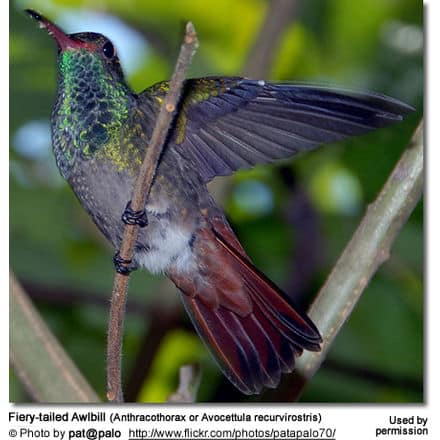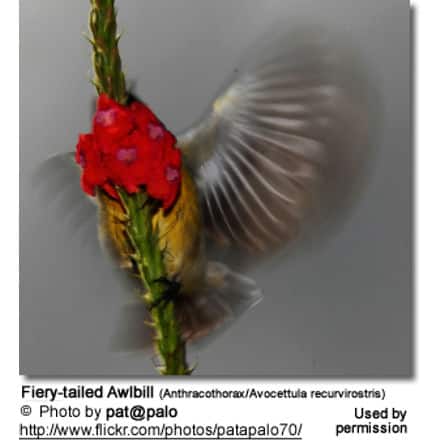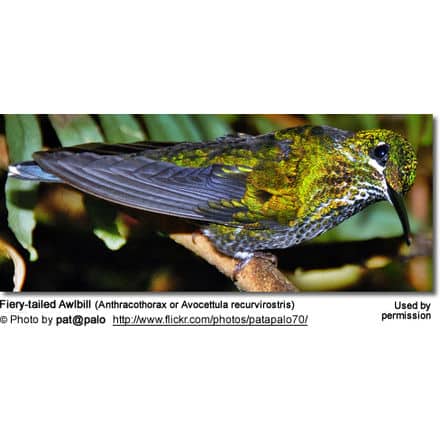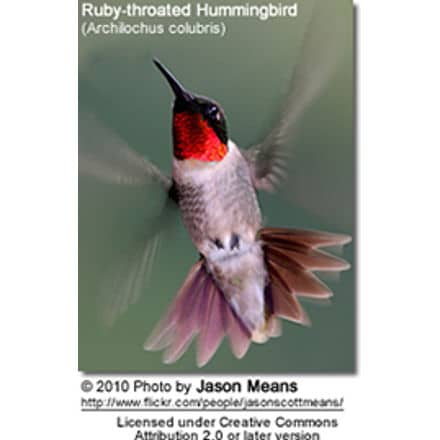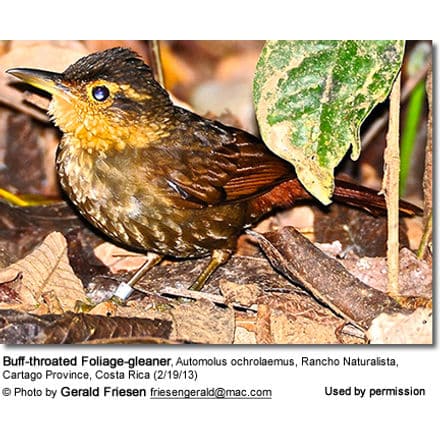Fiery-tailed Awlbills Or Swainson’s Hummingbirds
Fiery-tailed Awlbill Or Swainson’s Hummingbirds
Hummingbird Information
The Fiery-tailed Awlbill (Anthracothorax or Avocettula recurvirostris) – or Swainson’s Hummingbirds – are South American hummingbirds.
Distribution / Habitat
The Fiery-tailed Awlbills are found in southeastern Venezuela (Bolívar)
and the adjacent French Guiana, Guyana and Suriname, and south to north-central Brazil (lower Amazon east to Maranhão and Piauí). A disjunct population is said to occur in eastern Ecuador (Napo Valley).
Their preferred habitats are open savannas, forest clearings and edges, near creeks and rivers. They are particularly common near granite outcrops.
Description
Fiery-tailed Awbills measure about 3.1 – 4 inches (8 – 10 cm) in length (including the tail).
The male has an overall dark, glossy green plumage with a bronze gloss on the upper plumage, a violet tail (except for the slightly forked central pair of feathers, which are green); dull black wings and upper wing coverts (feathers) with green edgings, and a black streak across the abdomen.
The female is green above and white below, with a contrasting black stripe across the chest and white tips to the long tail feathers.
They have peculiar upturned bills, differentiating them from other hummingbirds that have either straight or down-curved bills. Their legs are black.
Similar Species:
The Fiery-tailed Awlbills resemble the Mango Hummingbirds (genus Anthracothorax), but can be identified by the distinctive sharp upturn at the tip of their bills.
Diet / Feeding
The Fiery-tailed Awlbill Hummingbirds primarily feed on nectar taken from a variety of brightly colored, scented small flowers of trees, herbs, shrubs and epiphytes, particularly Clusia and Dioclea. They favor flowers with the highest sugar content (often red-colored and tubular-shaped) and seek out, and aggressively protect, those areas containing flowers with high energy nectar.They use their long, extendible, straw-like tongues to retrieve the nectar while hovering with their tails cocked upward as they are licking at the nectar up to 13 times per second. Sometimes they may be seen hanging on the flower while feeding. They are often seen “*trap-lining” between favored plants (*traplining is a foraging strategy in which a bird visits a circuit of nectar sources, much as trappers check their lines of traps). Fiery-tailed Hummingbirds usually forage about 3.3 – 10 feet (1 – 3 meters) off the ground.
Many native and cultivated plants on whose flowers these birds feed heavily rely on them for pollination. The mostly tubular-shaped flowers actually exclude most bees and butterflies from feeding on them and, subsequently, from pollinating the plants.
They may also visit local hummingbird feeders for some sugar water, or drink out of bird baths or water fountains where they
will either hover and sip water as it runs over the edge; or they will perch on the edge and drink – like all the other birds; however, they only remain still for a short moment.
They also take some small spiders and insects – important sources of protein particularly needed during the breeding season to ensure the proper development of their young. Insects are often caught in flight (hawking); snatched off leaves or branches, or are taken from spider webs. A nesting female can capture up to 2,000 insects a day.
Males establish feeding territories, where they aggressively chase away other males as well as large insects – such as bumblebees and hawk moths – that want to feed in their territory. They use aerial flights and intimidating displays to defend their territories.
Breeding / Nesting
Hummingbirds are solitary in all aspects of life other than breeding; and the male’s only involvement in the reproductive process is the actual mating with the female. They neither live nor migrate in flocks; and there is no pair bond for this species. Males court females by flying in a u-shaped pattern in front of them. He will separate from the female immediately after copulation. One male may mate with several females. In all likelihood, the female will also mate with several males. The males do not participate in choosing the nest location, building the nest or raising the chicks.
The female is responsible for building the cup-shaped nest out of plant fibers woven together and green moss on the outside for camouflage in a protected location in a shrub, bush or tree. She lines the nest with soft plant fibers, animal hair and feather down, and strengthens the structure with spider webbing and other sticky material, giving it an elastic quality to allow it to stretch to double its size as the chicks grow and need more room. The nest is typically found on a thick branch of thick shrub or tree about 16.5 – 40 feet (5 – 12 meters) above the ground.
The average clutch consists of 1 -3 white eggs (mostly 2), which she incubates alone, while the male defends his territory and the flowers he feeds on. The young are born blind, immobile and without any down.
The female alone protects and feeds the chicks with regurgitated food (mostly partially-digested insects since nectar is an insufficient source of protein for the growing chicks). The female pushes the food down the chicks’ throats with her long bill directly into their stomachs.
As is the case with other hummingbird species, the chicks are brooded only the first week or two, and left alone even on cooler nights after about 12 days – probably due to the small nest size. The chicks leave the nest when they are about 20 days old.
Calls / Vocalizations / Sounds
Alternate (Global) Names
Chinese: ???? … Czech: Kolibrík guyanský, kolib?ík k?ivozobec … Danish: Flammehalet Sylnæb … Dutch: Vuurstaartkluutkolibrie … Finnish: Kurvinokkakolibri … French: Anthracothorax recurvirostris, Colibri à bec d’avocette, Colibri avocette, Mango avocette … German: Avosett Kolibri, Avosettkolibri, Säbelschnabelkolibri, Schwarzbauch-Avosettkolibri … Italian: Avocettina codaflammea, Colibrì beccoricurvo … Japanese: himesorihashihachidori … Norwegian: Knaggnebbkolibri … Polish: krzywodziobek … Portuguese: beija-flor-de-bico-virado … Russian: ????????????? ????????? … Slovak: jagavicka krivozobá, jagavi?ka krivozobá … Spanish: Colibrí de Pico Lezna, Mango Picolezna … Swedish: Sylnäbbskolibri
Metabolism and Survival and Flight Adaptions – Amazing Facts
Species Research by Sibylle Johnson
Overview … Alternate (Global) Names
Description … Calls / Vocalizations
Breeding / Nesting … Diet / Feeding
Please Note: The images on this page are the sole property of the photographers (unless marked as Public Domain). Please contact the photographers directly with respect to any copyright or licensing questions. Thank you.

